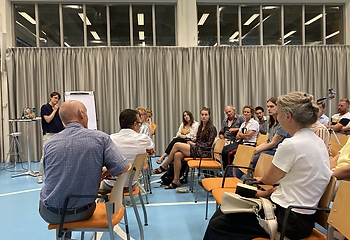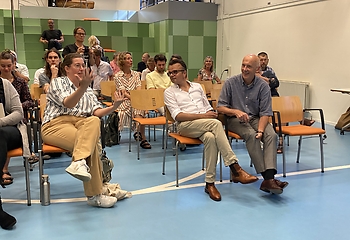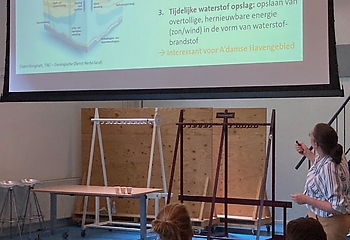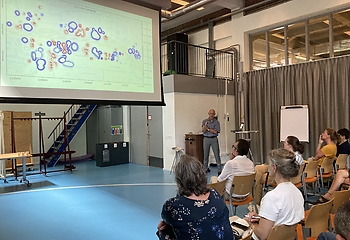The second meeting from the AWB series took place on Monday afternoon 11 September at De Gymzaal, Voormalige Stadstimmertuin 4 in Amsterdam. The three speakers told about their work in the different layers of the deeper underground.
First to speak was geologist Suzanne Hangx. She talked about her experimental research in the very deep subsurface at depths of up to 2-3 km. In particular about the rock layers in the Dutch underground, where, because of the energy transition, work is being done on geothermal heat extraction, long-term CO2 storage and temporary hydrogen storage. Technical geologist Frans Taselaar talked about his work on the energy and utilities in the Zuidas, with work up to 200 metres deep for the laying of cables and pipes, Aquifer Thermal Energy Storage and the first Dutch Integral Pipeline Tunnel (IPT) construction in high-city areas. Last in line, city archaeologist Ranjith Jayasena spoke about his (excavation) work in Amsterdam, which takes place mainly in the first six metres (below NAP) of the subsurface. Amsterdam has been building on soft soil since its inception, a legacy from the reclamation period, when peat was drained and started to settle. Because of the subsiding soil, it has to be raised all the time. Jayasena used maps and photos of excavated embankments to show the audience Amsterdam's complex (building) history.
All three speakers had reflected on what place microbes and vital soil life have occupied in their field so far. Yet little was the conclusion. But all three agreed that it is high time to pay more attention to this.
After the lectures, this time there was no breakout in small groups to answer some questions together. The three lectures were so interesting that the small breakout was exchanged for that.
Suzanne Hangx is assistant Professor 'Reservoir Mechanics & Geo-energy' at Utrecht University
Suzanne Hangx is an assistant professor at the High Pressure and Temperature Laboratory of the Department of Earth Sciences, Utrecht University, the Netherlands. She is also a board member of the Science for Sustainability community of the Pathways to Sustainability strategic theme. Her research is driven by her curiosity about the fundamental physical and chemical processes that determine the behaviour of rocks in the (deep) subsurface. She likes to juxtapose this research with its direct relevance to socially relevant issues, such as the effects of long-term oil/gas extraction, long-term CO2 storage, temporary hydrogen storage, geothermal energy production and radioactive waste storage.
Frans Taselaar is director consultancy and engineering firm Hompe and Taselaar (for space, environment and infrastructure), his company is based in Amsterdam.
Originally trained in geotechnics, Frans Taselaar graduated as an engineering geologist in Amsterdam and Delft. After a long career in consulting and contracting, at home and abroad, he started the firm Hompe and Taselaar, together with his partner Cees Hompe, in 2007. His companion sadly passed away in 2020. His versatile background enables Frans to support his clients at strategic, tactical and operational levels in the many complex issues that arise in the subsurface of the densely built-up urban area, such as the master plans (for energy and utilities) for the Zuidas.
Ranjith Jayasena is senior archaeologist at Bureau Monumentenzorg Amsterdam
Ranjith Jayasena studied archaeology at the University of Amsterdam (UvA) and has been a senior archaeologist at Monuments and Archaeology Bureau of the Municipality of Amsterdam since 2005. In 2019, he received his doctorate from the University of Amsterdam for the thesis ‘Excavation and mud work’. It is an archaeological urban history of Amsterdam and a first synthesis of 65 years of urban archaeology in Amsterdam (trade edition 2020). For his publication Graaf- en modderwerk, please visit here.




